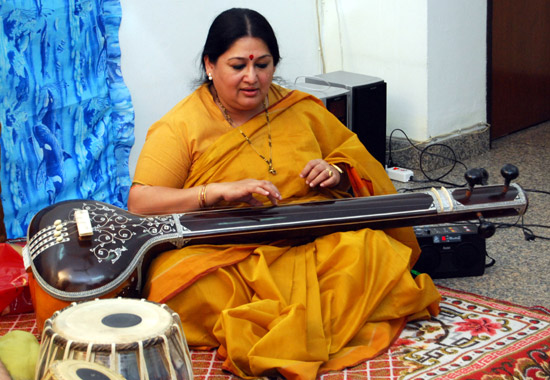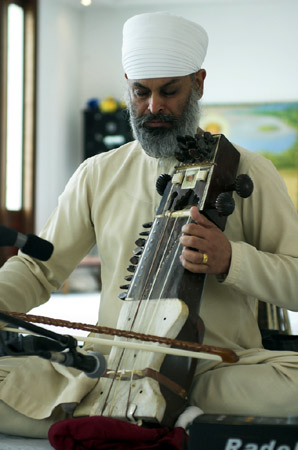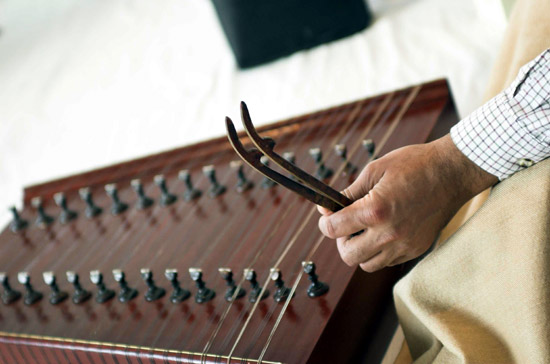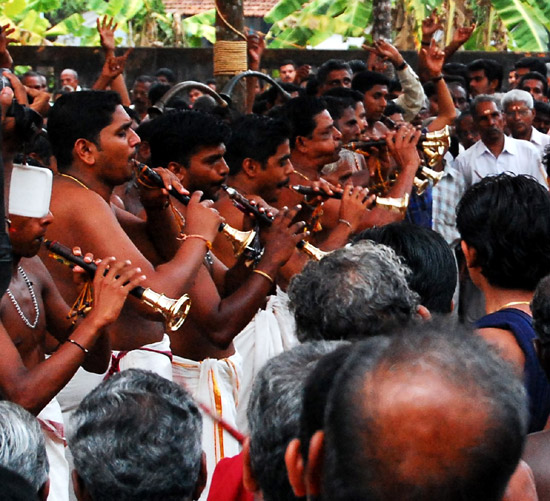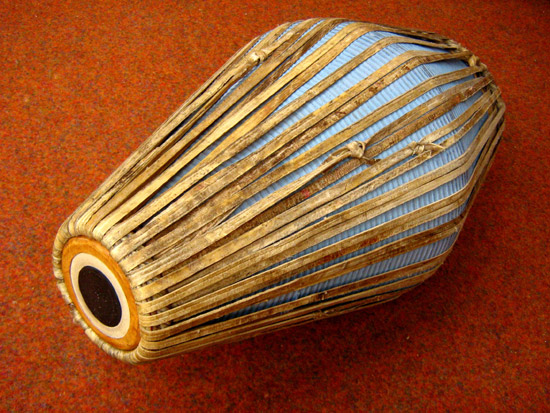Music: Instruments and Ensembles
Chordophones
Plucked or Strummed Strings: Saraswati Veena, Rudra Veena, Gottuvadhyam, Sitar, Sarod, Steel-String Guitar, and Tambura/Tanpura
Saraswati veena—often known simply as veena—is an ancient stringed instrument (Goddess Saraswati’s favorite) with a rounded wood resonator, a long neck with 24 frets (which may have a smaller resonator at the top end for balance), four playing strings, three drone strings, no sympathetic strings, and a slightly curved bridge. The veena is held at a sideways angle for playing, with the (main) resonator resting on the ground. Renowned instrumentalists on the veena include Sundaram Balachander and E. Gayathri.
Rudra veena has two rounded gourd resonators, a long, hollow neck, and steel strings that are plucked with a plectrum. Ustad Zia Mohiuddin Dagar is a prominent rudra veena soloist.
The comparatively new gottuvadhyam has six main strings, three drone strings, and a series of sympathetic strings that pass under the main strings. It is played with a slide, and features as a solo instrument in Carnatic music. Seetha Doraiswamy and N. Ravikiran are prominent performers.
The sitar has a rounded gourd resonator, with a badaa goraa (large bridge), a chota goraa (small bridge), and a long, hollow neck, with curved, movable metal frets, six or seven playing strings that run over the frets, and about 16 sympathetic strings that run under the frets. The instrument is rested at an angle between the player’s knee and foot, and played with a mizrab (plectrum). Ustad Vilayat Khan, Pandit Nikhil Banerjee, and Ustad Shujaat Khan are renowned Indian sitar players.
The fretless sarod, developed from the rubab (originally from Afghanistan), has playing, drone, and sympathetic strings, and is played with a plectrum in the right hand, using the left-hand fingernails to stop the metal strings. Ustad Ali Akbar Khan, Ustad Amjad Ali Khan, Pandit Vasant Rai, and Pandit Tejendra Majumdar are talented and well-known sarod performers.
The steel-string slide guitar, introduced to India in the 1950s, is usually modified, adding chikari (drone) strings and adjusting string height, to suit the requirements of the classical ragas and the individual musician’s technique. The four main types of Indian slide guitars are Devangui, Gandharvi, Anandi, and Chaturangui. Renowned slide guitarists include Brijbhushan Kabra, Pandit Debashish Bhattacharya, Pandit Vishwa Mohan Bhatt, and Manish Pingle.
The tambura/tanpura is a chordophone with a large pear-shaped resonator, a long, fretless neck, and four strings. There are three styles: Miraj, Tanjore, and the smaller tamburi. Tuned to the root notes of the raga (usually Sa—tonic—and Pa—dominant), its role in the music is to provide a background drone that constantly resonates to remind the performers of the basic tonality.
Bowed Strings: Sarangi, Esraj, Dilruba, Behala
The short-necked, fretless, and box-like sarangi has 3 or 4 playing strings and many sympathetic strings; it is played with a bow.
Esraj is a string instrument with a membrane-covered gourd resonator, a long neck with 20 metal frets, 4 main metal strings over the frets, and about 15 sympathetic metal strings under the frets. The instrument is rested on the knee and played with a gaz (bow).
The esraj is used in Rabindra Sangeet and Hindustani classical music. The very similar dilruba is used mostly by the Sikhs in Punjab.
The behala (violin) may be played in Western style, or while seated on the floor, with the scroll resting on the ankle or on the ground. Renowned players include Murad Ali and Sultan Khan (sarangi), Vinayaka Bora (esraj), and Kala Ramnath (behala).
Hammered Strings: Santoor
The Kashmiri santoor is a box-like hammered dulcimer with 24 to 100 strings (usually in triple or quadruple courses) that are played by striking with a pair of light mezrabs (mallets). Pandit Shiv Kumar Sharma is a renowned santoor player.
Aerophones
Baja, Bansuri, Shehnai, Nadaswaram
The hand-pumped, box-like baja (harmonium) pump-organ originated in France, but is now quite ubiquitous in Indian classical music and many other genres.
The bansuri flute, famous for its sensitive, melodious sounds, is a transverse bamboo instrument, with seven playing holes. It is an ancient instrument that is associated with cowherds, reputed to be Lord Krishna’s favorite instrument, and is used in classical music, folk songs, pop music, and rock music.
Usually played in temple festivals and at weddings, the shehnai has a conical wooden bore with eight finger holes and a brass bell. It is related to the nadaswaram, a longer, hardwood, double-reed wind instrument, also with a conical bore, and a metal or wood bell. The nadaswaram, which has seven finger holes and five intonation holes, is played in pairs at weddings and festivals, and in South Indian temple ensembles.
Renowned instrumentalists include Pandit Hariprasad Chaurasia and Ronu Majumdar (bansuri), Ustad Bismillah Khan (shehnai), and Subramania Pillai (nadaswaram).
Membranophones
Pakhwaj, Mridangam, Tabla, Kanjira, and Tavil
Pakhwaj and mridangam (or mridang) are double-faced cylindrical drums with tapering ends, and are hand played; the drums are held horizontally, hung on straps, or placed on the ground. Lord Shiva’s Tandav Nritya (Dance of Destruction) was performed to the thundering beats of the mridangam. Amir Khusro created the tabla by cutting the pakhwaj into two sections, the smaller dayan/tabla and the larger bayan/dagga. Kanjira, a small frame drum with metal jingles, is played with the mridangam.
The double-headed, barrel-shaped, and very loud tavil is played seated or standing, using the right hand on the right side and a stick on the left. It is used as a temple instrument in South India.
Renowned instrumentalists include Pandit Ravishankar Upadhyay (pakhwaj); Karaikudi R. Mani (mridangam); Ustad Zakir Husain, Pandit Swapan Chaudhuri, and Pandit Anindo Chatterjee (tabla); Govinda Harishankar (kanjira); and Karunamoorthy (tavil).
Idiophones
Morsing and Ghatam
The morsing, a jaw harp, has an elliptical metal frame with extended parallel arms and a thin metal strip in between. The long part is held against the teeth and the metal strip is hand-manipulated to produce the sound, with the mouth acting as the resonating chamber. Srirangam Kannan is a renowned morsing player.
Ghatam is a clay pot played with the palm and fingers; it features an open hole that can be covered (with the player’s abdomen) to alter the pitch and tone. T.V. Vaasan and Vikku Vinayakram are renowned performers on the ghatam.
Article written for World Trade Press by Sonal Panse.
Copyright © 1993—2024 World Trade Press. All rights reserved.

 India
India 